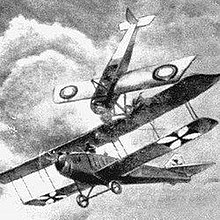
Back Atəş ramı AZ Паветраны таран BE Въздушен таран Bulgarian Rammstoß (Luftkampf) German Tarán Spanish Törmäysvoitto Finnish Taran French エアラミング Japanese Taran Dutch Воздушный таран Russian

Aerial ramming or air ramming is the ramming of one aircraft with another. It is a last-ditch tactic in air combat, sometimes used when all else has failed. Long before the invention of aircraft, ramming tactics in naval warfare and ground warfare were common. The first aerial ramming was performed by Pyotr Nesterov in 1914 during the First World War. In the early stages of World War II the tactic was employed by Soviet pilots, who called it taran (таран) , the Russian word for "battering ram".
A ramming pilot could use the weight of the aircraft as a ram, or they could try to make the enemy lose control of their plane, using the propeller or wing to damage the enemy's tail or wing. Ramming took place when a pilot ran out of ammunition yet was still intent on destroying an enemy, or when the plane had already been damaged beyond saving. Most rammings occurred when the attacker's aircraft was economically, strategically or tactically less valuable than the enemy's, such as pilots flying obsolescent aircraft against superior ones, or one man risking his life to kill multiple men.[1][2][3] Defending forces resorted to ramming more often than the attackers.[4][5]
A ramming attack was not considered suicidal in the same manner as kamikaze attacks—the ramming pilot stood a chance of surviving, though it was very risky. Sometimes the ramming aircraft itself could survive to make a controlled landing, though most were lost due to combat damage or the pilot bailing out. Ramming was used in air warfare in the first half of the 20th century, in both World Wars and in the interwar period. With jet aircraft, as air combat speeds increased, ramming became disused—the probability of successfully executing (and surviving) a ramming attack approached zero. However, the tactic is still possible in modern warfare.[6][better source needed]
- ^ Cite error: The named reference
Randwas invoked but never defined (see the help page). - ^ Whiting, Kenneth R. (1991). "The Soviet Air Force Against Germany and Japan". In Benjamin Franklin Cooling (ed.). Case Studies in the Achievement of Air Superiority. Air Force History and Museums Program. p. 195. ISBN 0-912799-63-3.
- ^ Boyd, Alexander (1977). The Soviet Air Force Since 1918. Stein and Day. p. 117. ISBN 9780812822427.
- ^ "Flying Rams".
- ^ "The perilous role of air-to-air ramming aircraft". 28 February 2020.
- ^ "Aerial Ramming Makes a Comeback".